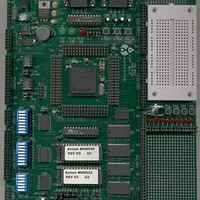MPC555CME Freescale Semiconductor, MPC555CME Datasheet - Page 578

MPC555CME
Manufacturer Part Number
MPC555CME
Description
KIT EVALUATION FOR MPC555
Manufacturer
Freescale Semiconductor
Type
Microcontrollerr
Datasheet
1.MPC555CME.pdf
(966 pages)
Specifications of MPC555CME
Contents
Module Board, Installation Guide, Power Supply, Cable, Software and more
Processor To Be Evaluated
MPC555
Data Bus Width
32 bit
Interface Type
RS-232
For Use With/related Products
MPC555
Lead Free Status / RoHS Status
Contains lead / RoHS non-compliant
- Current page: 578 of 966
- Download datasheet (13Mb)
15.15.4 MIOS1 Output Pulse Width Modulation With MDASM
MPC555
USER’S MANUAL
Output waveforms can be generated with any duty cycle without software involvement.
The software sets up a MDASM with the compare times for the rising and falling edges
and they are automatically repeated. The software does not need to respond to inter-
rupts to generate continuous pulses. The frequency may be selected as the frequency
of a free-running counter time-base, times a binary multiplier selected in the MDASM.
Multiple PWM outputs can be created from multiple MDASMs and share one counter
submodule, provided that the frequencies of all of the output signals are a binary mul-
tiple of the time-base and that the counter submodule is operating in a free-running
mode. Each MDASM has a software selectable “don’t care” on high-order bits of the
time-base comparison so that the frequency of one output can be a binary multiple of
another signal. Masking the time-base serves to multiply the frequency of the time-
base by a binary number to form the frequency of the output waveform. The duty cycle
can vary from one cycle to 64-Kbyte cycles. The frequency can range from 0.48 Hz to
156 KHz, though the resolution decreases at the higher frequencies to as low as seven
bits. The generation of output square wave signals is of course the special case where
the high and low times are equal.
When an MMCSM is used to drive the time-base, the modulus value is the period of
the output PWM signal.
leading edge of an output waveform is programmable for a rising or a falling edge. The
software selects the period of the output signal by programming the MMCSM with a
modulus value. The leading edge compare value is written into register A by software
and the trailing edge time is written into register B1. When the leading edge value is
reached, the content of register B1 is transferred to register B2, to form the next trailing
edge value. Subsequent changes to the output pulse width are made by writing a new
time into register B1. Updates to the pulse width are always synchronized to the lead-
ing edge of the waveform.
It is typical to use the pulse width modulation mode of the MDASM without interrupts,
although an interrupt can be enabled to occur on the leading edge. When the output
is an unchanging repetitive waveform, the MDASM continuously generates the signal
without any software intervention. When the software needs to change the pulse width,
a new trailing edge time is written to the MDASM. The output is changed on the next
full pulse. When the software needs to change the output at a regular rate, such as an
acceleration curve, the leading edge interrupt gives the software one period time to up-
date the new trailing edge time.
/
MPC556
MODULAR INPUT/OUTPUT SUBSYSTEM (MIOS1)
Figure 15-12
Rev. 15 October 2000
shows such an example. The polarity of the
MOTOROLA
15-42
Related parts for MPC555CME
Image
Part Number
Description
Manufacturer
Datasheet
Request
R

Part Number:
Description:
MPC555 Interrupts
Manufacturer:
Freescale Semiconductor / Motorola
Datasheet:
Part Number:
Description:
Manufacturer:
Freescale Semiconductor, Inc
Datasheet:
Part Number:
Description:
Manufacturer:
Freescale Semiconductor, Inc
Datasheet:
Part Number:
Description:
Manufacturer:
Freescale Semiconductor, Inc
Datasheet:
Part Number:
Description:
Manufacturer:
Freescale Semiconductor, Inc
Datasheet:
Part Number:
Description:
Manufacturer:
Freescale Semiconductor, Inc
Datasheet:
Part Number:
Description:
Manufacturer:
Freescale Semiconductor, Inc
Datasheet:
Part Number:
Description:
Manufacturer:
Freescale Semiconductor, Inc
Datasheet:
Part Number:
Description:
Manufacturer:
Freescale Semiconductor, Inc
Datasheet:
Part Number:
Description:
Manufacturer:
Freescale Semiconductor, Inc
Datasheet:
Part Number:
Description:
Manufacturer:
Freescale Semiconductor, Inc
Datasheet:
Part Number:
Description:
Manufacturer:
Freescale Semiconductor, Inc
Datasheet:
Part Number:
Description:
Manufacturer:
Freescale Semiconductor, Inc
Datasheet:
Part Number:
Description:
Manufacturer:
Freescale Semiconductor, Inc
Datasheet:
Part Number:
Description:
Manufacturer:
Freescale Semiconductor, Inc
Datasheet:










